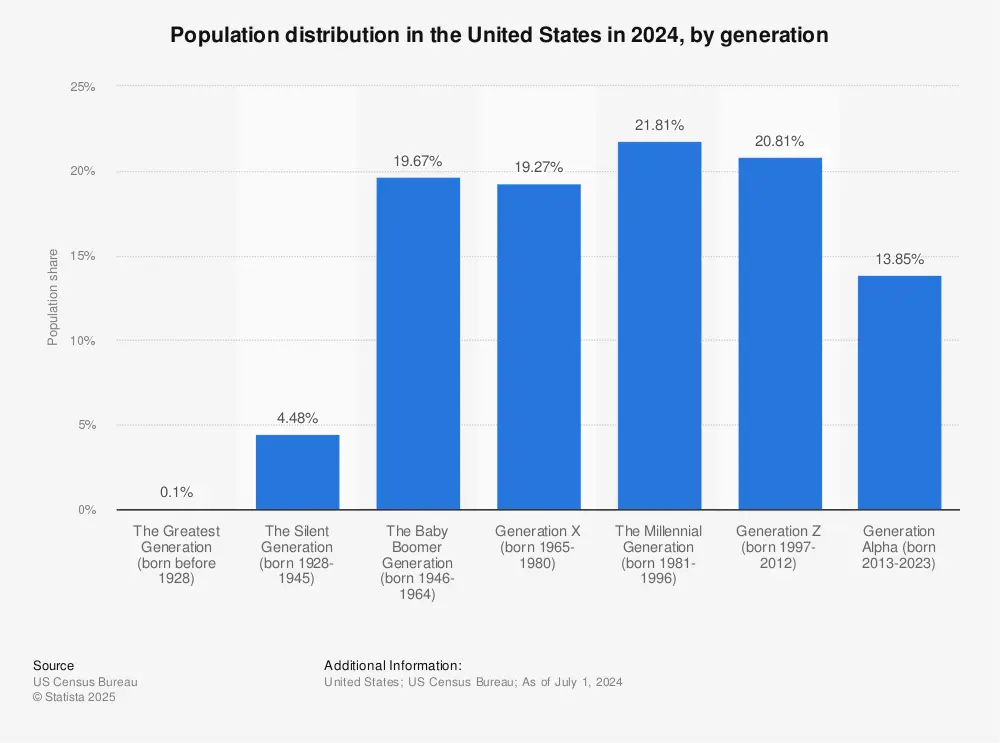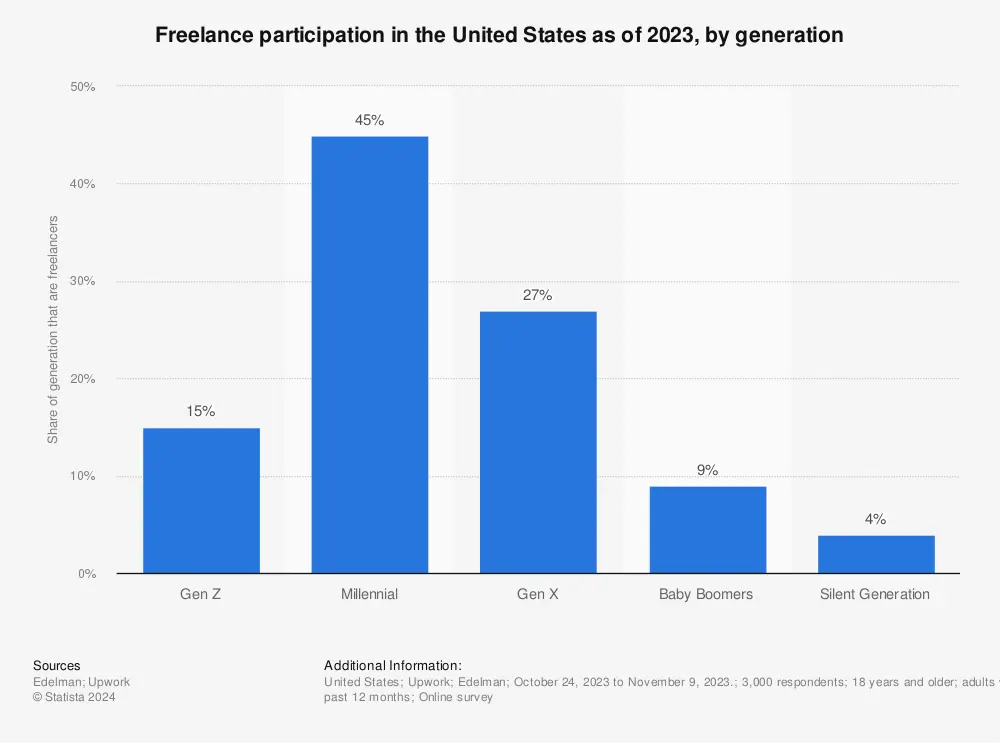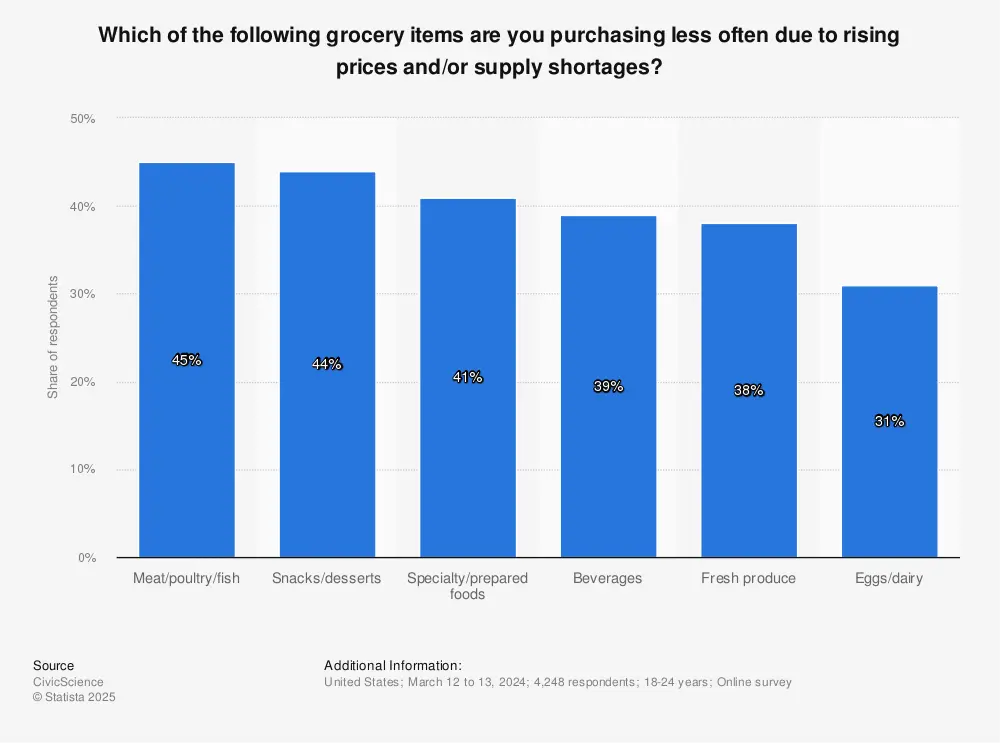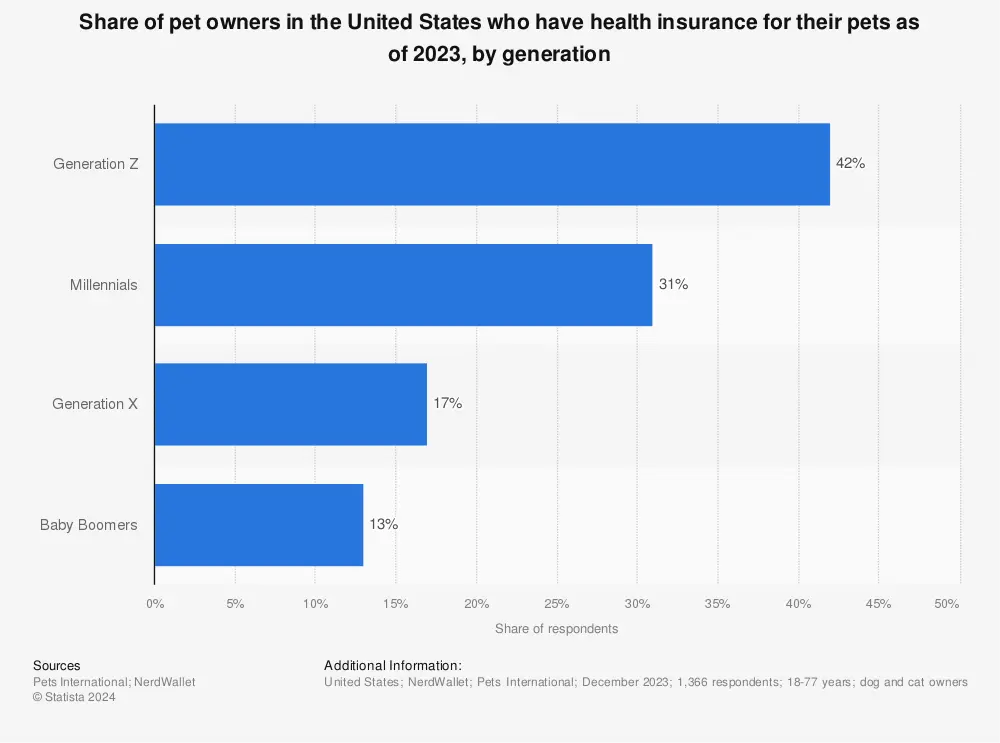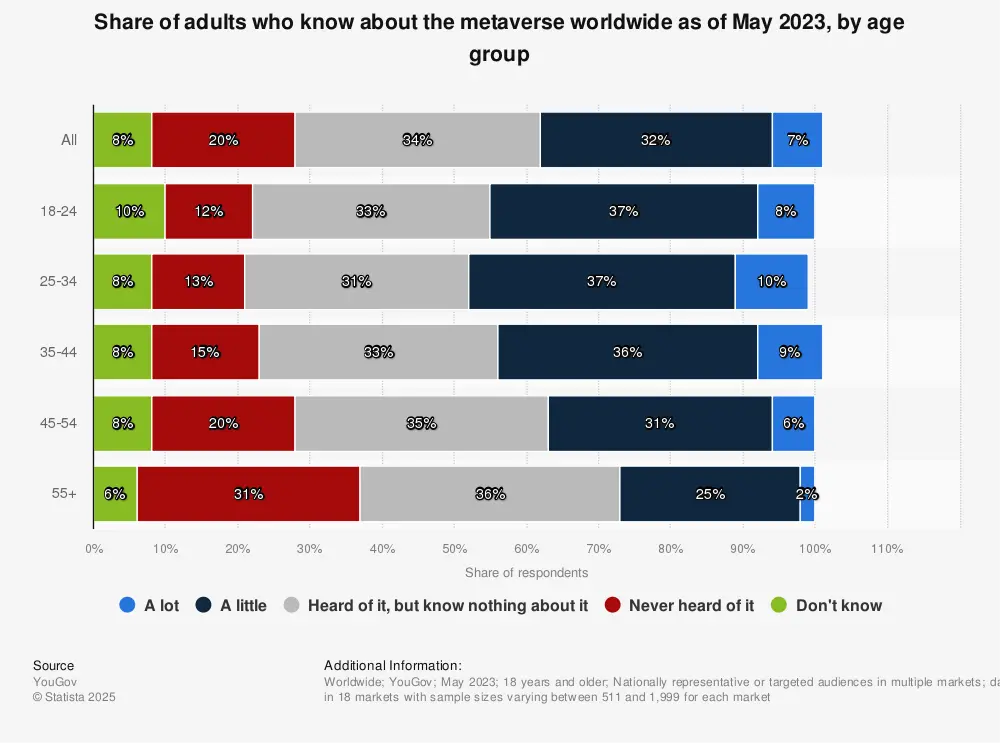Generation Z has grown up with the convenience of the internet and social media, but with the worry about climate change. Now, with more starting to enter the workforce, the question is how will their conveniences and concerns shape their purchasing habits.
Considering the increasing spending power they are starting to sway, marketing teams for Gen Z have devoted a lot of time to getting to know this younger generation better and identifying the fundamental differences across generations. We’ve scoured the web and summed up some of the most interesting Gen Z statistics in this blog post.
- Statistics for Gen Z's Spending Power
- Statistics for Gen Z’s Spending Categories and Trends
- Statistics for Gen Z Shopping Habits
- Statistics for Gen Z’s Values and Priorities in Purchasing Decisions
- Gen Z’s Financial Management Statistics
- Gen Z’s Marketing Preferences Statistics
- Statistics for Emerging Technologies and Shopping
Statistics for Gen Z's Spending Power
As more Gen Zers enter the workforce, their spending power will add a significant contribution to economies across the world. Here’s what we can expect in the next 10 years.
1. A 5th of the US population belong to Generation Z
So, just how many Gen Zers are there? They’re currently the third biggest generational group in the United States and account for 20.7% of the US population. So, considering that they make up a big percentage, you’ll want to continue reading to get to know them and what makes them tick better.
In fact, according to Spend Z: A Global Report (a collaborative effort among NielsenIQ, GfK, and World Data Lab), they represent 25% of the world’s population. This makes them the biggest generation to date and they’ll probably be the biggest one in history.
2. Their spending potential is expected to reach $12 trillion by 2030
According to Spend Z: A Global Report, Generation Z’s spend will grow at a compound annual growth rate (CAGR) of 4.02%. What makes this significant is that it’s twice the speed of the generations that came before them. It’s expected that in 2029 already it will overtake boomer spending.
3. The average American 25-year-old has an annual household income of $40,000+
The average American 25-year-old is already better off than what baby boomers and millennials were at the same age, according to Spend Z: A Global Report. Based on this report’s numbers, their annual household income exceeds $40,000.
4. Gen Z accounts for ± 17.1% of the total global spend
To get a more realistic picture of Gen Z’s spending power, Spend Z: A Global Report used purchasing power parity (PPP) to account for inflation and currency fluctuation.
Currently, Gen Z drives about 17.1% of the total global spend of $57.6 trillion. It’s expected that it will increase to $12.6 trillion by 2030, 18.7% of the total global spend.
5. 15% freelance
While many Gen Zs are still too young to be formally employed, according to Statista 15% of Gen Z in the US freelance.
NielsenIQ reports that by 2030 a third of the global workforce will be Gen Zers. As they’ve been raised in the “gig economy” it will be interesting to note how many will then work as freelancers and which side hustles will add to their spending power.
Statistics for Gen Z’s Spending Categories and Trends
So, what does Gen Z spend their money on or influence their household to purchase? The following stats show that they’re all for having a good time, but as long as they look and feel good.
6. They spend the most on food, drink, and beauty
When Gen Z consumers were asked which category they spend the most on per month, the answer was simple—food and drink. About twice as many say their grocery store bill is higher than their restaurant tab, showing that it’s mostly more sensible shopping than splurging.

Source: statista.com
That said, supply shortages and/or rising prices are causing them to cut back on:
- Meat
- Snacks
- Deserts
- Specialty/prepared foods
Just over 40% of Gen Zers are purchasing these food items less often.
According to Spend Z: A Global Report, beauty products also feature regularly in their baskets. In both the US and UK, Gen Z consumers over-index on beauty items.
7. Disney+ slightly more popular than Netflix
After food and drink, entertainment is the category that they spend the most money on. Over 95% of younger Gen Zs watch TV content via streaming services each month, of which about a third pay for a streaming service, according to the Digital 2024: Global Overview Report.
As for which streaming services they prefer, Disney+ and Netflix are two of the main streaming services popular among Gen Z subscribers. Nearly 30% are on Disney+, while just over a quarter are on Netflix.

Source: emarketer.com
The available content is also the main factor that keeps them subscribed. About 75% list new releases as a motivator to keep paying. Cost is the secondary decision factor.
8. Over 40% list gender-neutral clothing as important
Younger generations are more likely to buy gender-neutral clothing, according to a survey completed in 2023 among US consumers.
Of all the generations, Gen Z was the most likely to have bought apparel that didn't fall into their gender identity category. More than 40% of Gen Zs listed that gender-neutral clothing is the most important feature when shopping for apparel.
9. 52% splurge on experiences when traveling
Travel is a popular activity among Generation Z. A global survey completed at the beginning of 2024 reveals that about 75% of the Gen Z travelers interviewed planned to take a solo trip in the upcoming year.
Motivated by an urge to treat themselves to something special, they’re also the generation most willing to splurge on experiences during their trip. Just over half of Gen Zs who participated in another global survey completed at the beginning of 2024 revealed that they planned to indulge in experiences.
10. Gen Z travelers prefer hotel accommodation
When it comes to their accommodation preferences when traveling, hotels are the most popular type. In a survey completed in November 2023, about six out of 10 Gen Z travelers indicated that they stayed in a hotel during their last trip. Vacation rentals were in the second spot.
11. About four out of 10 have pet insurance
While Gen Z is the least likely to own a pet (only 16% are pet owners), they’re the most likely to have pet insurance of all the generations. A survey completed in 2023 reveals that 42% of Gen Zers have health insurance for their cat or dog.
On the other hand, compared to millennials, they spend less on pet health care and food.
Statistics for Gen Z Shopping Habits
While Gen Z hasn’t known the world before the internet, surprisingly, the convenience of online shopping isn’t dictating their shopping habits. They embrace social media platforms but still appreciate the social element of in-store shopping.
12. In-store purchases account for nearly half of their share of dollars
Gen Z shoppers more often start their search online than at a physical store (44% vs 35%). However, that’s not necessarily where it ends.
According to Spend Z: A Global Report, their in-store grocery and mass merch purchases add up to about half their share of dollars. So, if your target audience is Gen Z, it’s key that you promote across multiple channels instead of concentrating solely on online shopping.
13. 96% of US Gen Z shoppers shop online monthly
According to stats shared by Statista, a massive 96% of Gen Z consumers in the US admit to shopping online at least once per month. What’s more, about a third admitted to online shopping being a daily habit.
14. Nearly half have participated in live-stream shopping
Live-stream shopping is gaining momentum among Gen Z in the US. A survey that looked at livestream awareness and participation reveals that 46% of Gen Z consumers have participated in such an event.
For Gen Z, the main perks of these live-stream shopping events are:
- Exclusive discounts
- Inspiration
- Real-time engagement
- Interactivity
15. 46% use mobile phones to shop online
When it comes to online shopping, 46% of Gen Z have used mobile phones to make a purchase. That said, computers are equally popular with 45% using them to buy something online.
Tablets, on the other hand, are much less popular. Only 9% shopped online using a tablet.
16. Nearly 70% have made a purchase because of social media
Younger consumers, like Gen Z, are more inclined to let their purchasing decisions be influenced by social media. A survey completed in 2023 reveals that almost seven out of 10 Gen Zs in the US have bought an item that had popped up in their social media feed.
They’re also comfortable with social commerce. Spend Z: A Global Report reveals that 53% have used social networks’ buy buttons.
17. 36% have used TikTok for beauty purchases
As an earlier statistic reveals, beauty products are one of the main categories on which they spend money. TikTok has the biggest impact of their purchase decisions for this category with 36% relying on the platform. In fact, they’re more than three times as likely as millennials to turn to TikTok for beauty buys.
Statistics for Gen Z’s Values and Priorities in Purchasing Decisions
Authenticity, sustainability, and quality—these are three key values that drive Gen Zers’ purchasing choices. That said, if they were to choose between the impact a purchase will have on the environment or their bank balance, cost wins.
18. Authenticity is their top value
The Spend Z: A Global Report reveals that “being true to yourself” is the best description of how Gen Z sees success. They’re interested in authentic relationships with brands and social media influencers.
Self-esteem and belonging are two other values that could have an impact on what they buy.
19. Quality and price are the most influential drivers
A product’s quality and price are the biggest two purchase drivers among Gen Z shoppers. While they care about the environment, whether a product is socially responsible, produced locally, or sustainable only has about a third of the impact that price has.
Considering that for 34% their top concern is the cost of living, this makes sense. While they’re worried about climate change, only two out of 10 lists this as their biggest worry, according to the Deloitte Global 2024 Gen Z and Millennial Survey.
20. Nearly 80% won’t support countries with poor environmental standards
Climate change is not only a concern for this generation, but it also impacts their purchasing decisions. At least, that’s what they claim.
According to The Spend Z: A Global Report, 77% say they won’t buy products from a country that has poor environmental standards. In the same breath, the report questions if it materializes into action considering their collection of tech gadgets and fast fashion.
21. 64% will pay more for sustainable products
While value is a more important factor than sustainability, Deloitte’s survey found that nearly two-thirds will pay more to buy a product that’s environmentally sustainable. That said, they’ll spend only up to 10% more if the product is sustainable, according to the Spend Z: A Global Report.
Price aside, they also feel very strongly that businesses can and should do more to help consumers make more sustainable purchasing decisions, with 79% sharing this sentiment according to the Deloitte survey.
22. As much as 50% can possibly follow vegan diets
One way that Gen Z tries to fight climate change by means of their purchasing choices is to eat less meat. A survey completed at the beginning of 2024 in Great Britain reveals that Gen Z has the highest share of adults who plan to enjoy a meat-free diet in the coming year. On top of the 26% who were already following meat-free diets, about another 26% planned to eliminate meat from their diets.
These numbers are in line with Deloitte’s findings. According to their numbers, 26% of Gen Z are already eating a vegan or vegetarian diet, while another 24% plan to do so.
23. Gen Z are more willing to buy secondhand
Seeing that Generation Z consumers are more aware of the impact that their buying behavior has on the environment, they’re also the generation that’s more willing to purchase secondhand apparel.
A survey completed in the US at the beginning of 2023 reveals that 42% of the consumers who engaged in secondhand shopping belonged to Gen Z.
More than half were driven by price, while about a third turned to thrift stores to find vintage items. They were also more likely than older generations to say that sustainability and environmental impact were the main reasons for buying secondhand products.
24. 53% are willing to explore new brands
While a big percentage of Gen Z shoppers are happy to settle for secondhand items, they’re also open to exploring new products. In search of variety, just over half of Gen Z shoppers are willing to consider new brands. Part of this brand exploration is driven by the fact that they’re more likely to let celebrities influence their purchasing patterns.
Even better yet, if the product has a fun or novel element. Along with millennials, they search for everyday products that are unusual and exciting.
25. 67% believe private labels are as good as national brands
Another way that price influences their purchasing choices is when it comes to private labels. According to the Spend Z: A Global Report, the majority (67%) of Gen Zs feel that private labels are as good as national brands.
26. Only 19% of Gen Zs feel small businesses offer a convenient online experience
Gen Zs want to support small businesses. However, a GoDaddy survey reveals that convenience is standing in the way.
Only 19% of Gen Z shoppers feel that small businesses in the US offer a convenient online experience. If they managed to match the level of convenience offered by bigger chain stores, 73% of Gen Z would support them more.
Examples of features that Gen Z wants small businesses to offer include:
- An option to pay online and pickup in-store
- Contactless digital payments
- The option to buy via the social media page of the business
Gen Z’s Financial Management Statistics
As a number of the earlier statistics show, Gen Zs are price-sensitive shoppers. They value good value for money. However, does that mean that they’re also sensible when it comes to managing their own finances?
27. A third plan to budget
Recent global financial concerns have left their mark on Gen Z. Nearly 60% are living from paycheck to paycheck, according to the Deloitte Global 2024 Gen Z and Millennial Survey.
In light of these economic challenges, stats shared by Statista reveal that about 30% of Gen Z shoppers plan to budget carefully. This includes buying only what they need more often.
That said, the same percentage are optimistic that the economy will improve within the next year, according to Deloitte’s survey. Plus, nearly a half of Gen Zs feel that this change will impact their personal finances positively too.
28. About a quarter plan to buy a home in 2024
A survey completed among more than 15,000 US participants revealed that more or less 25% of the Gen Z generation had plans to buy a home before June 2024. That said, Gen Z buyers made up only 3% of homebuyers in 2023, with nearly half listing affordability as a challenge to finding a home.
29. 37% of US Gen Zers have made at least one BNPL purchase recently
According to EMARKETER, Gen Z is the main growth driver of Buy Now, Pay Later (BNPL) users. About a third (37%) of Gen Z respondents in a Morning Consult survey have indicated that they’ve used BNPL recently to make a purchase.

Source: emarketer.com
At the same time, they’re also the most likely to miss a payment, according to an online survey. The same source also found that about a quarter (24%) admit to spending more using BNPL than they should have.
As for how much the average Gen Z consumer spends, it adds up to about $1,230 in the last 90 days.
It’s mainly used to buy clothing and electronics. Nearly 40% use BNPL for clothing purchases, while 10.6% use it for electronics, according to The Credit Economy: How Younger Consumers Make Credit Decisions report, a survey completed by PYMNTS and i2c.
30. Half of Gen Z use credit cards for the rewards
According to The Credit Economy: How Younger Consumers Make Credit Decisions report, 50.1% of Gen Z used a credit card for a purchase because of the rewards. Better spending management, it’s the second-leading reason driving credit card purchases among this group.
31. Consumer credit usage has changed significantly for a third of Gen Zs
Of all the generations, Gen Z was the most likely to have used more credit products in the past year. About a third of Gen Zers have answered in the survey conducted by PYMNTS and i2c that they’ve used credit products more.
This was especially the case for occasional purchases with 35.3% admitting that they’ve used credit somewhat to significantly more.
Gen Z’s Marketing Preferences Statistics
It takes a combination of personalization and social media marketing to reach and appeal to Gen Z. While they spend a lot of time on social media, they still have a use for email too. Then, to keep your branding healthy, ensure that you prioritize mental health—that’s how you win their minds.
32. 47% of Gen Z want personalized product recommendations
Of all the generations, personalized product recommendations matter the most to Gen Z. A survey completed in April 2023 among over 17,000 consumers reveals that nearly half of Gen Z prefer personalized suggestions when shopping online.
Another survey reveals that over half (55%) of Gen Z have already bought a product that generative AI recommended.
33. 84.9% want to receive personalized offers
Personalized offers are nearly double as important to Gen Z than personalized product recommendations. A survey completed by PYMNTS Intelligence and AWS about US consumers’ preferences regarding personalized merchant offers reveals that a massive 84.9% of Gen Zs are interested in receiving such offers.
What’s more, the same survey found that a third will shop with a new merchant if it meant receiving better personalization.
Free shipping and discounts are the preferred offers, each scoring about 33% of the votes. About 10% indicated that they’re interested in receiving exclusive access to new products.
34. About half prefer to receive personalized offers via email
As for how they prefer to receive these offers, email is the winner. After email, text messages, and app notifications are the preferred communication channels to receive personalized deals with both scoring the vote of 29.6% of Gen Z participants.
35. 72% use Instagram for sending DMs
When it comes to preferred communication channels, Instagram is the top pick for sending direct messages (DMs). Data shared by EMARKETER reveals that 72.2% of Gen Z use Instagram for this purpose, while less than half (45.6%) use TikTok for DMs.

Source: emarketer.com
36. Snapchat and TikTok are their most popular channels
While Instagram is their preferred way to send DMs, Snapchat, and TikTok are more popular among Gen Z. Over half of Snapchat users are Gen Z, while 44.7% of TikTok users belong to this generation. Gen Z make up a third (33.7%) of Instagram users, according to EMARKETER’s data.
37. 53% want brands to support mental health
A survey completed by ICSC and Big Village reveals that mental health is the most important cause that Gen Zs want brands to support. It’s followed by:
- Climate change
- Sustainability
- Racial or gender equity
Statistics for Emerging Technologies and Shopping
Here’s how emerging tech is shaping the ways Gen Zs shop.
38. About 45% are aware about the metaverse
A global survey completed in May 2023 revealed that Gen Z (and millennials) were the age groups that were the most aware of metaverse activities.
Only 12% have never heard about the metaverse. That said, the majority know very little about it, with only about 8% feeling that they know a lot.
39. Nearly a third wants to shop virtually with friends
The Spend Z: A Global Report reveals that about one out of three Gen Z shoppers would like to shop virtually with their friends. It’s also expected that both shopping in virtual stores as well as virtually shopping with friends will increase in the next five years by 229% and 141% respectively.
40. 61% feel positive about AI-generated content
According to EMARKETER, 61% of Gen Z feel positive about AI-generated content on social media. They also view AI as a useful tool that can help with tasks like travel planning and editing.
41. 31% use AI platforms to find info
Not only are Gen Zers using AI for tasks, but also to find information. EMARKETER data reveals that 31% use AI platforms/chatbots like Bard and ChatGPT to find information.
42. 60% are interested in AI-enabled shopping
A research collaboration between PYMNTS and ACI Worldwide has found that 60% of Gen Z shoppers are interested in AI-enabled shopping experiences. Using AI for banking also got their attention, with 52.8% showing interest.

Source: pymnts.com

